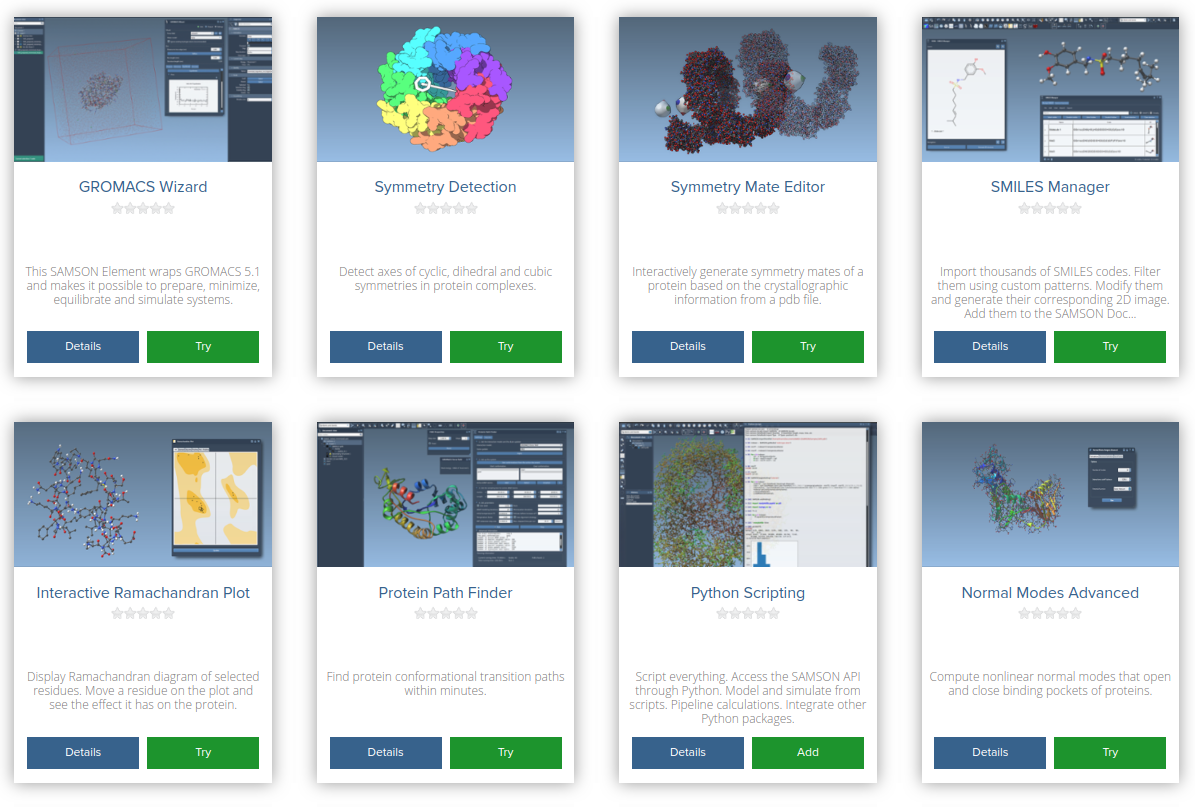SAMSON has an open architecture which allows you to extend it, and adapt it to your needs, by downloading SAMSON Elements (modules) from the SAMSON Connect website. SAMSON Elements come in many flavors: apps, editors, controllers, models, parsers, etc., and are adapted to different application domains. SAMSON Elements help users build new models, perform calculations, run interactive or offline simulations, visualize and interpret results, and more.
The first time you start SAMSON, it downloads a set of default SAMSON Elements from SAMSON Connect. Later you can extend your SAMSON installation by adding more SAMSON Elements.

SAMSON Elements
SAMSON Elements are modules for SAMSON that you add from SAMSON Connect. The first time you start SAMSON, some default SAMSON Elements are automatically installed.
SAMSON Elements may contain Apps, Editors, Importers, Exporters, Visual models, Interaction models, and State updaters.
Apps may provide any type of functionality. For example, an app may be a connector to an external executable or web service, may wrap previously developed code to integrate its functionality with SAMSON and other SAMSON Elements, or provide entirely new functionality. To start using an app, click on it from either the App menu or the App toolbar. See Apps for more information.
Editors are one of the main ways to interact with documents. Editors receive user events (e.g. mouse and keyboard events) and use these events to provide potentially complex editing functionality. For example, an editor may be a rectangle selection tool, a nanotube generator that lets users create a new nanotube model in a few clicks, a tool for deforming molecular structures while preserving local rigidity, a tool to apply a rigid-body transform to a model, etc. Editors are positioned in the Edit menu and the Editors toolbar. See Editors for more information.
Importers are dedicated to parsing files. An importer may be e.g. a PDB parser, an electron density parser, etc. See Importers for more information.
Exporters are dedicated to exporting content from the document to files. An exporter may be e.g. a PDB exporter, an XYZ exporter, etc. See Exporters for more information.
Visual models provide visual representations in the viewport. A visual model may be e.g. a secondary structure representation applicable to protein models, an electron density isosurface, a volume rendering of an electrostatics field, etc. See Visual models for more information.
Interaction models are responsible for computing energies and forces and are used in SAMSON to perform various modeling and simulation tasks. An interaction model could be e.g. a spring model, an elastic network model, an extended Hückel model, etc. See Interaction models for more information.
State updaters implement methods used to advance states during simulations. State updaters may be e.g. minimization algorithms, Monte Carlo methods, molecular dynamics algorithms, etc. See State updaters for more information.
Add/Remove a SAMSON Element
To add/remove SAMSON Elements, sign in to your account on SAMSON Connect, then go to the SAMSON Connect - Elements section to choose the SAMSON Elements you need.
Please, see the SAMSON Connect Elements section for more information.
Develop a SAMSON Element
To start developing your own SAMSON Element you need to download the SAMSON SDK. For that, you need to obtain a developer status.
Sign in to SAMSON Connect, go to the section My SAMSON, request the SAMSON developer's status. Once you obtain the developer status, you will be able to download the SAMSON SDK.
To learn more how to install SAMSON SDK and create a SAMSON Element we refer to the SAMSON Developer guide and SAMSON Developer tutorials.

